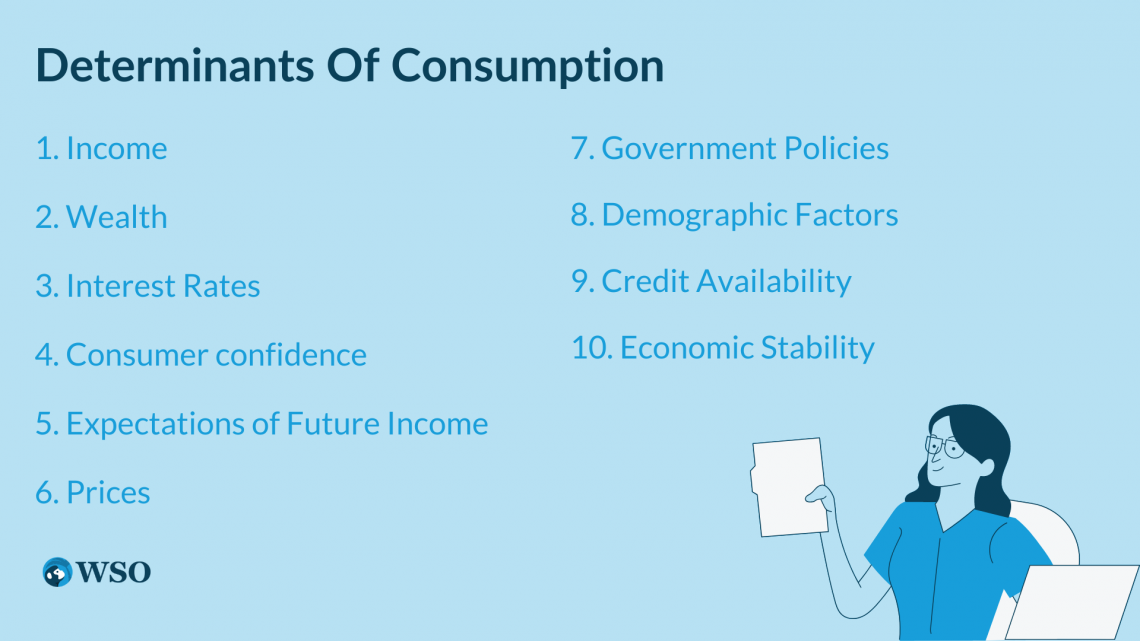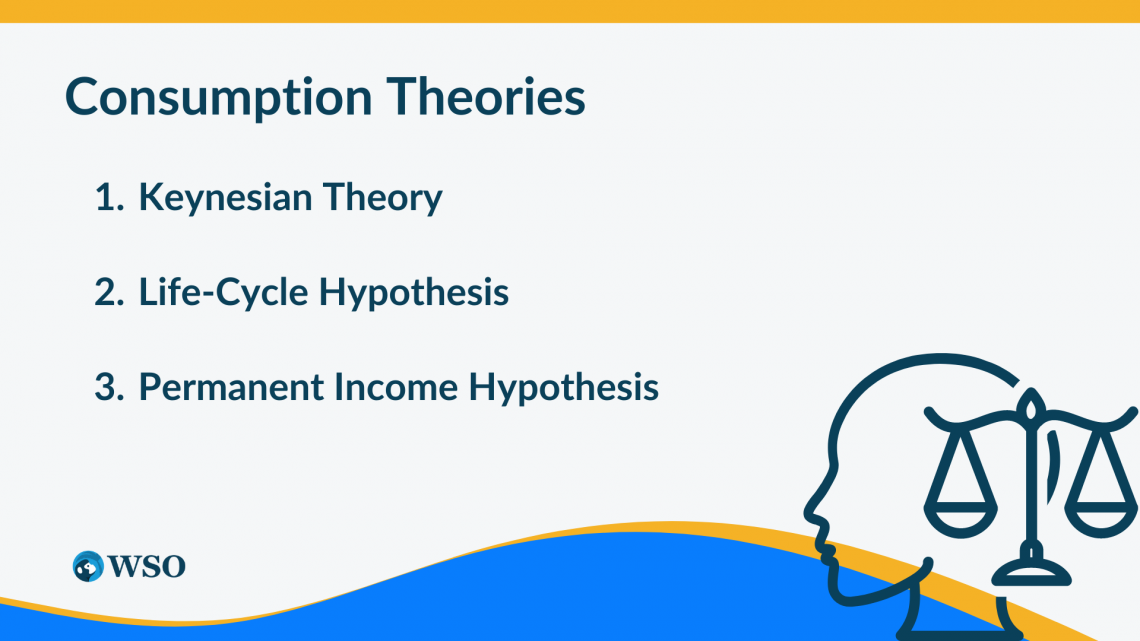Consumption
Refers to the act of utilizing goods and services to meet human wants and needs
Consumption (C) refers to the act of utilizing goods and services to meet human wants and needs.

It incorporates various activities, from purchasing necessities like meals and apparel to buying long-lasting items, including motors and homes. It can also include non-material items and offerings like education, healthcare, and leisure.
One of the key concepts is its characteristic, which describes the connection between income and the amount of expenditure.
This characteristic enables economists to analyze how modifications in income affect consumption styles and how people allocate their assets between C and S. It is represented graphically as a consumption curve.
Economists also differentiate it between two types:
1. Autonomous consumption (AC)
2. Induced consumption (IC)
AC refers to the level of spending that occurs even in the absence of any income. In contrast, IC refers to the extra spending due to increased income.

This distinction is essential in understanding the multiplier impact, wherein an initial increase in spending leads to a chain reaction of additional spending in the economy. It additionally has implications for the overall economy. It is a main component of aggregate demand, representing the economy's total spending.
Changes in consumption will have multiplier consequences on other sectors, including investment and government spending, and can influence economic increase and employment levels.
A decrease in Consumption can lead to reduced production and job losses during economic downturns, while an increase can stimulate economic activity.
Key Takeaways
- Consumption is a key component of economic activity and refers to the act of using goods and services to satisfy human wants and needs.
- It encompasses various activities, including purchasing necessities, durable goods, and non-material items such as education and healthcare.
- Various factors influence it, including income, wealth, interest rates, consumer confidence, prices, government policies, demographic factors, credit availability, and economic stability.
- Income plays a crucial role in determining C levels, with higher incomes generally leading to increased spending on goods and services.
- Wealth also influences C levels, as individuals with higher wealth levels have more resources for discretionary spending.
- Interest rates affect C by influencing borrowing costs and the affordability of financing C through credit.
- Consumer confidence can influence C patterns, reflecting perceptions of the economy and personal finances. High consumer confidence generally leads to increased spending, while low confidence can result in cautious behavior and reduced C.
Consumption in Microeconomics and Macroeconomics
In the context of both microeconomics and macroeconomics, consumption refers to the individual or household use of goods and services to fulfill wants and needs.

Microeconomic analysis focuses on studying how individuals make decisions based on factors such as their preferences, income, and prices of goods.
It examines consumer behavior, demand theory, and utility maximization to understand how individuals allocate their resources to maximize satisfaction.
On the other hand, in macroeconomics, it is studied at the aggregate level, considering the entire economy. Macroeconomists analyze the overall consumption, production, investment, and government spending levels.
They examine factors that influence aggregate consumption, such as:
- National income
- Savings rates
- Consumer confidence
NOTE
By studying consumption in micro and macro contexts, economists gain insights into how individual choices and broader economic factors shape the functioning and performance of the economy as a whole.
Understanding it is essential for studying economic growth, employment, inflation, and overall economic stability.
Both microeconomics and macroeconomics consider the impact of modifications in profits, prices, and different elements on consumption decisions. Even as microeconomics focuses on individual options and behavior, macroeconomics examines the implications of aggregate consumption patterns for the overall economy.
Here's a tabular explanation of Consumption in microeconomics and macroeconomics:
| Basis | Microeconomics | Macroeconomics |
|---|---|---|
| Focus | Individual behavior and decision-making. | Aggregate behavior and the overall economy. |
| Level of analysis | Individual households and consumers | The economy as a whole |
| Scope | Narrow focus on specific markets | Broader focus on overall economic conditions. |
| Variables Considered | Individual income, prices, and preferences | Aggregate income, overall price level, and C trends. |
| Consumption function | Relationship between income and C | Relationship between national income and C |
| Impact on economy | Individual C affects individual well-being and market dynamics | Aggregate C impacts economic growth, employment, and inflation |
| Policy implications | Micro-level policies for individuals and households | Macroeconomic policies to manage aggregate C, stabilize the economy |
Determinants of Consumption
The determinants are crucial factors that influence individuals' spending on goods and services. Understanding these determinants is essential for analyzing consumer behavior, predicting C patterns, and formulating effective economic policies.

Here are some key determinants:
1. Income
Income is a fundamental determinant. Generally, as income increases, people have more disposable income available for spending. This leads to higher C levels. However, the relationship between income and consumption is not one-to-one.
As income rises, the marginal propensity to consume (MPC), which represents the portion of additional income spent, tends to decrease.
2. Wealth
Wealth, including financial assets, real estate, and investments, can impact it. Higher levels of wealth often lead to increased C.
NOTE
Wealth can provide individuals with a sense of financial security and the ability to make discretionary purchases beyond basic needs.
3. Interest Rates
Interest rates influence borrowing costs and the cost of financing consumption through credit. High-interest rates can discourage borrowing and lead to reduced consumption.
4. Consumer confidence
It represents people's perspectives on the economy's present and future conditions. Low consumer confidence can lead to cautious spending behavior and lower consumption levels and vice versa.
5. Expectations of Future Income
Consumers' expectations of future income and employment prospects can impact their decisions.
NOTE
If there are chances to rise in income, individuals will spend more, otherwise vice versa.
6. Prices
The relative prices of goods and services influence consumption decisions. Consumers may reduce their consumption of those goods as prices rise or seek cheaper alternatives. Similarly, lower prices can encourage increased consumption.
7. Government Policies
Government policies, such as fiscal measures (taxation, transfers) and monetary policies (interest rates, credit availability), can significantly influence it. Tax cuts or increased government transfers can boost disposable income and encourage spending.
NOTE
Policies that increase taxes or reduce government transfers may dampen C.
8. Demographic Factors
Demographic characteristics, such as age, household composition, and cultural factors, can impact C patterns. For example, young households may have different C patterns than older households. Cultural norms and societal expectations also influence C decisions.
9. Credit Availability
The availability of credit and access to financing options can affect C. Easy access to credit can stimulate spending, while restrictive credit conditions can limit C.
10. Economic Stability
Economic stability, including inflation rates, unemployment levels, and economic growth, can influence C. Stable economic conditions give individuals a sense of security and confidence, supporting higher C levels.
Consumption theories
Economists have proposed various theories to understand and explain consumer behavior and the factors that drive C. Here are three prominent C theories:

1. Keynesian Theory
Developed by John Maynard Keynes, the Keynesian theory emphasizes the role of income and aggregate demand in determining C. According to Keynes, it is primarily driven by current disposable income.
He argued that individuals tend to consume a smaller proportion of their additional income as income increases, leading to a diminishing marginal propensity to consume (MPC).
NOTE
The Keynesian theory also highlights the importance of AC, which represents C that occurs even in the absence of income, driven by factors like borrowing or savings.
2. Life-Cycle Hypothesis
The life-cycle hypothesis, developed by Franco Modigliani, suggests that individuals base their decisions on their lifetime income rather than current income alone.
According to this theory, individuals strive to maintain a stable level of C throughout their lifetime, smoothing it over high and low-income periods.
Therefore, people may save at times of high income (like throughout their working years) to support spending during low income (like retirement).
NOTE
The life-cycle hypothesis also considers the role of wealth accumulation and bequests in shaping C patterns.
3. Permanent Income Hypothesis
Proposed by Milton Friedman, the permanent income hypothesis argues that individuals’ decisions for C are based on their perceived permanent income rather than transitory fluctuations in income.
Permanent income refers to the average income individuals expect to receive over the long term. According to this theory, individuals adjust their C based on changes in their perceived permanent income rather than short-term income fluctuations.
This suggests that even brief changes in income, such as a bonus or windfall, would not cause a noticeable rise in C.
NOTE
These theories highlight the importance of income, wealth, expectations, and other factors in determining C patterns. They provide insights into individuals' spending, savings, and borrowing decisions.
Moreover, these theories have implications for economic policy. Keynesian theory, for instance, contends that governmental actions to increase income or raise aggregate demand may favor spending and economic expansion.
The life-cycle hypothesis emphasizes the need for long-term financial planning and policies supporting individuals in retirement savings. The permanent income hypothesis underscores the role of stable income expectations in shaping C behavior.
Conclusion
In conclusion, consumption is crucial in individuals' and societies' economic growth and social well-being. Various factors influence it and have significant implications for the overall economy.

It is essential for policymakers and economists to understand its patterns and impacts in formulating effective economic policies and promoting sustainable development.
Microeconomics specializes in consumers' individual selections and actions, whereas macroeconomics examines it as a component of combination demand.
Understanding patterns and their determinants is essential for both fields to analyze economic behavior, make policy recommendations, and assess the performance of economies.
It serves as a measurement of economic growth by reflecting spending patterns and demand within an economy. It contributes significantly to GDP and affects employment levels and income distribution.
NOTE
It's important to note that determinants interact and influence each other, creating complex dynamics in consumer behavior.
Keynesian theory, life-cycle hypothesis, and permanent income theories represent different perspectives and approaches to understanding it. Its patterns are complex and influenced by various psychological, sociological, and cultural elements, even though they offer useful insights.
Researchers continue to refine and develop C theories to capture the complexities of consumer behavior in an ever-changing economic landscape.
By deepening our understanding of consumption and its drivers, we can better navigate economic challenges, promote sustainable growth, and improve the well-being of individuals and societies.









or Want to Sign up with your social account?